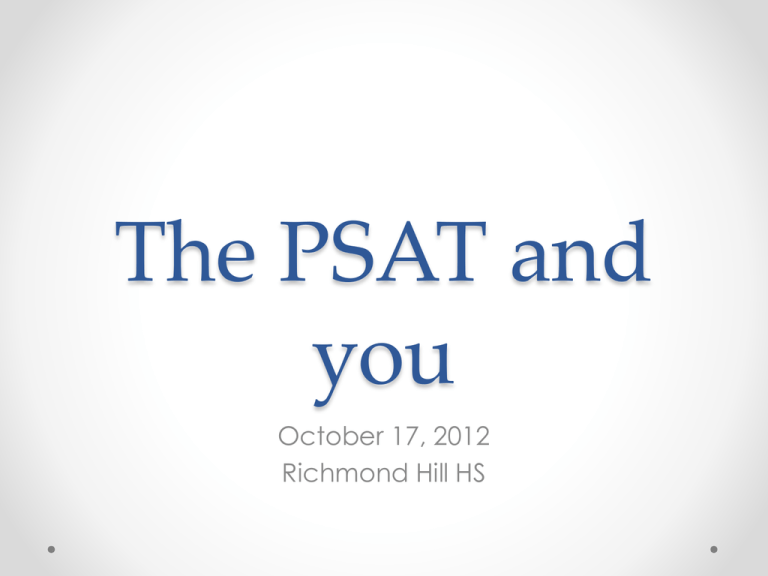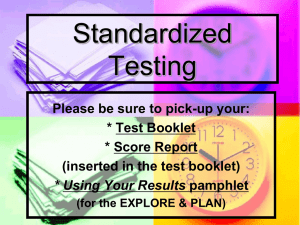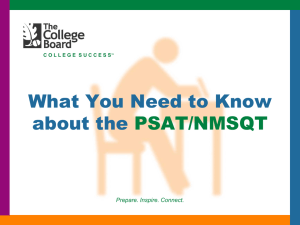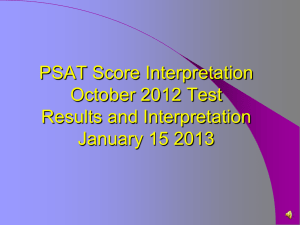raw scores
advertisement

The PSAT and you October 17, 2012 Richmond Hill HS So you now have taken the PSAT • What does it all mean? What is the PSAT, anyway? • PSAT is the short form of Preliminary SAT. It is also known as NMSQT or National Merit Scholarship Qualifying Test. The test acts as an opportunity for practice for the SAT Reasoning Test. Besides, you can qualify for the National Merit Scholarship Corporation (NMSC) scholarship programs on the basis of the exam. Does Taking PSAT help you? Yes, taking PSAT is definitely helpful to students. It becomes more important for you to take the PSAT if you are contemplating taking the SAT for college admission. The key benefits of taking the PSAT are PSAT Benefit One • It assists you in preparation for SAT. The test items in PSAT and SAT are similar and hence PSAT can qualify as an excellent opportunity to practice for SAT. Benefit Two: • The exam helps as a self-evaluation tool. You understand what your weak points are and can concentrate on those. Moreover, understanding what your strong points are helps you make the most of them. Benefit three: • You get an idea of where you stand in competition with other SAT aspirants owing to the reporting of percentiles in PSAT. Benefit four • You can avail the opportunity for entering programs for scholarships. PSAT acts as an initial screening of aspirants for some scholarship programs Benefit five • You can sign up for Student Search Service and hence get information from colleges about their admission and scholarship programs. What does the PSAT measure? • The exam tests students for the knowledge they have gained and the abilities they have developed through years of education. The basic skills required for successfully completing college level education are evaluated in PSAT. However, the pattern of PSAT is such that recall of precise details is not required The exam puts a figure on three main skills Critical Reading Math problemsolving Writing Understanding PSAT Scoring Procedure • Initially, raw scores are calculated and then they are converted to scaled scores for each section. The scaled scores range from 20 to 80. Tell me more… • To calculate the raw score, each correctly answered question is given one point. All the questions are rated equally. An incorrect response will result in a negative ¼ point; except for grid-ins. Unanswered questions do not have any negative impact on the raw score. More on scoring… • The raw scores are converted to scaled scores through a method called equating. This is done to equalize any difference that might exist between tests administered on different dates in different years. Hence, equating makes scaled scores comparable. Features of PSAT that are useful to Colleges and Students • Percentiles are given on the score report for each section. Juniors and sophomores can compare their performances with other juniors and sophomores. This gives them an understanding of where they stand at a national level. Percentile? What’s a percentile? A test score in and of itself is usually difficult to interpret. For example, if you learned that your score on a measure of shyness were 35 out of a possible 50, you would have little idea how shy you are compared to other people. More relevant is the percentage of people with lower shyness scores than yours. This percentage is called a percentile. If 65% of the scores were below yours, then your score would be the 65th percentile. More about PSAT Scoring • Students are given information about their weaknesses and related suggestions for improvement in the Score Report Plus under ‘Improve Your Skills’. You will get your score report in a several weeks. How does this help me? • The score report includes a complete review of the answers including the correct answer, your response and level of difficulty for each question is given in Score Report Plus. This helps students understand their performance. Do colleges see my score • Please note that your actual PSAT scores are not sent to colleges. They do not use the results of this test to determine eligibility for admission. Colleges do not look closely at PSAT scores So this is why you took the PSAT today to receive feedback on your strengths and weaknesses on skills necessary for college study. You can then focus your preparation on those areas that could most benefit from additional study or practice. to see how your performance on an admissions test might compare with that of others applying to college. to help prepare for the SAT. You can become familiar with the kinds of questions and the exact directions you will see on the SAT. to receive information from colleges if you checked"yes" to Student Search Service.









